5ὃ�ᫀ
���ʔʔʔ
1ஹ�ᫀ�5ὃ�5I┯�ᡈὅAḄY⚪A���Z�ὶ�4ᦟ
2ஹʟʠɎ�▤��ᜧ�����ᙠ`�ᳮYḄ_⚪�ψAZ�ὶ�4ᦟ
3ஹὃ��⌕ʖ9Ạ⚪L��ᜧ��ɢ�⍝���5ḄLᐵM�F
4ஹ�ᫀ5�Ȝ�Ȇ?5Ȍ8���Ḅ⊡�
������1���Q1
Let ωmax(x) be the state of nature for which P (ωmax|x) ≥ P (ωi|x) for
all i, i = 1, ..., c.
(a) Show that P (ωmax|x) ≥ 1/c
(b) Show that for the minimum-error-rate decision rule the average
(c) Use these two results to show that P (error) ≤ (c − 1)/c
(d) Describe a situation for which P (error) = (c − 1)/c
probability of error is given by P (error) = 1 − P (ωmax|x)p(x)dx
(a)�
ᵫP (ωmax|x) ≥ P (ωi|x)��
P (ωmax|x) + ··· + P (ωmax|x)
c �
= cP (ωmax|x) ≥ P (ω1|x) + ··· + P (ωc|x) = 1
P (error) = P (error, x)dx = P (error|x)p(x)dx���x�ᐸ���ȊωmaxḄ
ᡠ�ᨵcP (ωmax|x) ≥ 1�ᓽP (ωmax|x) ≥ 1/c
(b)�
Ȝ ᭆ᳛�P (ωmax|x)�ᡠ�ᢥ᯿⚪L�Ḅᑖ�3ᑣ��x Xᑨ�ωmaxA�
P (ωmax|x)p(x)dx
1/cp(x)dx
p(x)dx
1
≤ 1 −
= 1 − 1
c
c − 1
c
=
P (error|x) = 1 − P (ωmax|x)
P (error|x)p(x)dx =
[1−P (ωmax|x)]p(x)dx = 1−
P (ωmax|x)p(x)dx
ᡠ��
P (error) =
(c)�
�MP (ωmax|x) ≥ 1/c�
P (error) = 1 −
�
��p(x|ωi)p(ωi)ḄᦪǷ�ωiAᐵA�5��P (error) =
(d)�
P (ωi|x) = p(x|ωi)p(ωi)
(c − 1)/c
p(x)
������1���Q2
In many pattern classification problems one has the option either to
assign the pattern to one of c classes, or to reject it as being unrec-
ognizable. If the cost for rejects is not too high, rejection may be a
desirable action. Let
0
λr
λs
λ(αi|ωi) =
i = j
i, j = 1, ..., c
i = c + 1
otherwise
where λr is the loss incurred for choosing the (c + 1)th action, rejec-
tion, and λs is the loss incurred for making a substitution error. Show
that the minimum risk is obtained if we decide ωi if P (ωi|x) ≥ P (ωi|x)
for all j and if P (ωi|x) ≥ 1 − λr
, and reject otherwise. What happens
if λr = 0? What happens if λr > λs?
λs
��᪵ʠx��ᐸXᑨ���Ȋωi���ᑖ�Ḅb◅��A�ὃ⇋>��
c
j=1
Ri =
λ(αi|ωj)P (ωj|x)
j=i
λsP (ωj|x)
= 0 × P (ωi|x) +
= λs[1 − P (ωi|x)]
ʧ>��ᑣ��᪵ʠx�b◅�Rr = λr��P (ωi|x) ≥ 1− λr
λs
A���Ri�Rr:
Ri − Rr = λs[1 − P (ωi|x)] − Rr
− 1) − λr
≤ λs(1 +
λr
λs
= 0
ᓽRi − Rr ≤ 0�ᑨ�ωiḄb◅����>�Ḅb◅
�λr = 0A�>���ᙠb◅�ᑖ��ᙠϏ�Ḅb◅�ᡠ�ᡠᨵḄ᪵ʠZ�X
>�
�λr > λsA�ᨵRr = λr > λs ≥ Ri = λs[1 − P (ωi|x)]�ᓽ�Rr > Ri�>�Ḅ
b◅ɛʖ�ᑖ�b◅ ��A>�Ḅʡᑴᜫᦔ
2
�
������1���Q3
Now we have N samples, and each sample xi,
i = 1, ..., N has d-
dimensions. Please provide us the proofs and the pseudo-codes of
PCA algorithm
PCAʖ�Oτ�A��� �᪵ʠᢗ�ᑮ���_������_Ḅ᪵ʠ[�
8ț;�_A�[���ᨬ�M▣X = (xc
N ) ��ᦪɼ`�ᐸ�:
2, ..., xc
i = xi − µ, xi ∈ Rd×1, i = 1, ..., N
xc
1, xc
µ =
1
N
?�ᩭ��ȖA�M▣�
N
xi
i=1
Σ = XX T
ΣḄʠ�Ƿ᪀ᡂ�YM▣��ᜐ�λ1, λ2, ..., λd�ᜧᑮ�ᑡ�
Λ��Ḅʠ�ᔣ[᪀ᡂd × dM▣�
Λ = Diag(λ1, λ2, ..., λd)
Φ = (φ1, φ2, ..., φd)
⌱>ʠ�ǷᨬᜧḄm�ʠ�ᔣ[����_Ḅ9���ʠ�ᔣ[�ᡂᢗ�M
▣W �
΅��@��5��ᐰZᦪɼτᑮm��
W = (φ1, φ2, ..., φm)
Z = W T X
�ʔ�✌ᐜ�PCA⌕��ᙠᦪɼτ�ᢗ��Ȝ���ᐸᙠᢗ�ȜḄ��ᜧA
�ᙠ���ᙶ᪗�O����ᡂᑖ ����ᜧA�ᙠ���ᙶ᪗����ᡂ
ᑖ ������?�Z��W �⌱3��ᢗ�ᔣ[φj�φj3��xiᙠ���
_Ḅ�j�ḄᦪǷφT
j xi���φj�A���
Ej = φT
j XX T φj
LȌḄ�ᓄL᪗��5ᑮᔠ〉Ḅφj�ᐸᨬᜧᓄEj�ᙠ�ʣφT
ᔠ>ʫᨽA����ᓄL᪗5��
j φj − 1 = 0���
JEj = φT
j Σφj + λj(φT
j φj − 1)
�JEj
�φj����ᦪ�`ᜐ�ᑮᔠ〉Ḅφj��ᑮ�
ʗᯠ�φj�ʠ�ᔣ[������ᩩ�
Σφj + λjφj = 0
3
�
������1���Q4
Consider the following decision rule for a two-category one-dimensional
problem: Decide ω1 if x > θ; otherwise decide ω2.
(a) Show the probability of error for this rule is given by P (error) =
P (ω1) θ
−∞ p(x|ω1)dx + P (ω2) ∞
θ p(x|ω2)dx
(b) By differentiating, show that a necessary condition to minimize
P (error) is that θ satisfy p(θ|ω1)P (ω1) = p(θ|ω2)P (ω2)
(c) Does this equation define θ uniquely?
(d) Give an example where a value of θ satisfying the equation actu-
ally maximizes the probability of error
(a)�
�x ≤ θA�ᑨ3�ω2�ᡠ���ZᑖḄ┯�᳛�ȕ_(−∞, θ]�x�ω1Ḅᭆ
᳛�
P 1(error) =
=
θ
θ
θ
−∞
−∞
p(ω1|x)p(x)dx
p(x, ω1)
p(x)dx
p(x)
p(x|ω1)p(ω1)
=
−∞
θ
−∞
θ p(x|ω2)dx�ᡠ��
= p(ω1)
p(x)dx
p(x)
p(x|ω1)dx
p(x|ω1)dx + p(ω2)
θ
−∞
∞
θ
p(x|ω2)dx
Ȝᳮp2(error) = p(ω2) ∞
P (error) = p(ω1)
(b)�
dP (error)
dθ
= p(ω1)p(θ|ω1) − p(ω2)p(θ|ω2)
(c)�
�P�3θḄȨ�Y�8��� p(θ|ω1)
(d)�
�x ≤ θA�ᑨ3�ω2�5��ᑨ3�ω1�Z���Ȋω2Ḅ�⌕ᭆ᳛ᑖ�ាɕ
ᙠ(θ,∞)ȕ_�̠��Ȋω1Ḅ�⌕ᭆ᳛ᑖ�ាɕᙠ(−∞, θ)ȕ_�5̠����
�ᑨ3YᑣḄ��᳛�ᜧ
ḄθǷ���ᨵ��
p(θ|ω2) = p(ω2)
p(ω1)
������1���Q5
Consider the multivariate normal density for which σij = 0 and σii =
σ2
i , i.e., Σ = diag(σ2
2, ..., σ2
1, σ2
d).
4
�
(a) Show that the evidence is p(x) =
(b) Plot and describe the contours of constant density
(c) Write an expression for the Mahalanobis distance from x to µ
d
i=1( xi−µi
σi
)2]
exp[− 1
2
2πσi
1d
√
i=1
(a)�
ɏ� A��
p(x) =
1
2 |Σ| 1
(2π) d
2
exp[− 1
2
(x − µ)T Σ−1(x − µ)]
�ᐭ⚪L�ᩩ���ᑮ�
2d
1
p(x) =
(2π) d
i=1 σi
d
(
i=1
xi − µi
σi
)2]
exp[− 1
2
(b)�
��ᔣ[x1�x2�Rp(x1) = p(x2)�ᑣᨵ�
d
i=1
d
i=1
(
x1
i
σi
− µi
σi
)2 =
(
x2
i
σi
− µi
σi
)2
, ..., µd
σd
]Ḅ�OL��ᡠ�� �ᙠ
1, x1
2, ..., x1
d]ȤF[x2
d]ᑮF[ µ1
ᓽF[x1
σ1
��<3��ʴᙊ�ᙠ �<3���ʴᳫ
(c)�
�O��
2, ..., x2
1, x2
d
i=1
xi − µi
(
)2
σi
∞
a e− µ2
������1���Q6
Let p(x|ωi) ∼ N (µi, σ2I) for a two-category d-dimensional problem with
P (ω1) = P (ω2) = 1
2
(a) Show that the minimum probability of error is given by Pe =
1√
2π
(b) Let µ1 = 0 and µ = (µ1, ..., µd)t. Use the inequality from [Pattern
Classification, Chapter 2, Problem 31] to show that Pe approaches
zero as the dimension d approaches infinity.
(c) Express the meaning of this result in words
2 dµ, where a = ||µ2 − µ1||/(2σ)
(a)�
5
�
R1
R1
ȕ_R1�ᑨ��ω1�ȕ_R2�ᑨ��ω2�
p(ω2|x)p(x)dx +
P (error) =
p(ω1|x)p(x)dx
R2
p(ω1, x)
R2
p(x)
p(ω2, x)
p(x)
=
p(x)dx +
p(x)dx
= p(ω2)
p(x|ω2)dx + p(ω2)
p(x|ω1)p(ω1)dx
R1
p(x|ω2)dx +
R2
p(x|ω1)dx
1
2
R2
1
2
=
=
R1
p(x|ω2)dx
R1
ʠ⚪��ᐹ�Ḅᑨ3Yᑣ��x�µ1�O��ᑣᑨ3�ω1��µ2�O��ᑣᑨ
3�ω2�ὃ⇋ᑨ�ω1Ḅ<3�
i )2 − (xi − µ2
i )x − (µ2
[(xi − µ1
i )(µ2
i + µ1
i )] < 0
i − µ1
[2(µ2
i − µ1
i )2] =
i
���ᓄ��
i
y = (µ2 − µ1)tx <
2 µ2 − µT
(µT
1 µ1)
1
2
y�᪗[�ᡠ���ᑖ�ḄᙳǷᑖȊ5�(µ2 − µ1)T µ1Ȥ(µ2 − µ1)T µ2�A�ᙳ
�σ2||µ2 − µ1||2��Aɴɏ�ᔣ[������ʹᜐᳮ�
P (error) =
p(x|ω2)dx
R1
√
=
1
2πσ||µ2 − µ1||
∞
(µ2−µ1)T µ1+w(µ2−µ1)T µ2
2
exp(− (y − (µ2 − µ1)T µ2)2
2σ2||µ2 − µ1||2
)dy
ᵨu = y−(µ2−µ1)T µ2
σ||µ2−µ1|| Bᣚᣵy��ᑮ�
P (error) =
1√
2π
∞
||µ2−µ1||
2σ
exp(− u2
2
)du
(b)�
�ᔠ�Mᩩ��
Pe ≤
√
1
||µ2−µ1||
2σ
2π
e− (||µ2−µ1||
2σ
2
)2
Pe ≤
2σ√
2π||µ2|| e
− ||µ2||2
8σ2
�Ϗ`ᔣ[µ2Ḅ�A�ᜧA�Pe��`
(c)�
�ʔ��� �ᦪɼ�5ᑖ
6
�
������2���Q1
n
n
Let the sample mean ˆµn and the sample covariance matrix Cn for a
set of n samples x1, ..., xn ((each of which is d-dimensional) be defined
k=1(xk − ˆµn)(xk − ˆµn)t. We call these
k=1 xk and Cn = 1
by ˆµn = 1
n−1
n
the ’non-recursive’ formulas.
(a) What is the computational complexity of calculating ˆµn and Cn
by these formulas?
(b) Show that alternative, ’recursive’ techniques for calculating ˆµn
and Cn based on the successive addition of new samples xn+1 can be
n+1 (xn+1 − ˆµn) and
derived using the recursion relations: ˆµn+1 = ˆµn + 1
Cn+1 = n−1
(c) What is the computational complexity of finding ˆµn and Cn by
these recursive methods?
n+1 (xn+1 − ˆµn)(xn+1 − ˆµn)t.
n Cn + 1
(a)�
�������ᙳǷA�n�᪵ʠ���n�4���ᐳd��Ɏᩖ��O(dn)�
�ȖA�M▣CnA�����᪵ʠ��˯�d2�������ᐳn�᪵ʠ�ᡠ
���Ɏᩖ��nd2
(b)�
⌴�ḄA��ˆµn+1�
n+1
1
xi
n + 1
i=1
1
n + 1
(xn+1 +
n
i=1
ˆµn+1 =
=
=
=
xi)
n
i=1
1
n + 1
(xn+1 + n × 1
n
xi)
1
n + 1
xn+1 +
n
n + 1
ˆµn
(xn+1 − ˆµn)
= ˆµn +
1
n + 1
7
�
⌴�A��Cn+1 = n−1
n Cn + 1
n+1 (xn+1 − ˆµn)(xn+1 − ˆµn)t�
(xk − µn+1)(xk − µn+1)T
k=1
n+1
n
n
k=1
k=1
n
Cn+1 =
=
=
=
1
n
1
n
1
n
1
n
1
n
(xk − µn+1)(xk − µn+1)T +
(xn+1 − µn+1)(xn+1 − µn+1)T
1
n
[xk − µn − 1
n + 1
(xn+1 − µn)][xk − µn − 1
n + 1
(xn+1 − µn)]T +
(xn+1 − µn+1)(xn+1 − µn+1)T
(xk − µn)(xk − µn)T −
1
n(n + 1)
(xn+1 − µn)
n
k=1
1
−
n
(xk − µn)T
k=1
(xk − µn)(xn+1 − µn)T +
1
(n + 1)2 (xn+1 − µn)(xn+1 − µn)T
ᐸ��n
k=1
n(n + 1)
[xn+1 − µn − 1
n + 1
(xn+1 − µn)][xn+1 − µn − 1
n + 1
1
+
n
k=1(xk − µn)T �`ᔣ[�ᡠ�����ஹ�⚗5��◀�
(n + 1)2 (xn+1 − µn)(xn+1 − µn)T
Cn+1 =
Cn +
n + 1
(xn+1 − µn)]T
n − 1
n
n − 1
n
Cn +
1
n + 1
(xn+1 − µn)(xn+1 − µn)T
(c)�
����ᑭᵨᓫ᪵ʠBAµ������ʹ��43������ḄɎᩖ�
�O(d)���ᑭᵨᓫ�᪵ʠBACA�ʹd2������ᡠ�Ɏᩖ��O(d2)
������2���Q2
exp[− 1
2
In Pattern Classification, Chapter 3, Page 77, we have f (σ, σn) =
)2]dµ, now please calculate f (σ, σn), give the
(µ− σ2
σ2+σ2
n
σ2σ2
n
nx+σ2µn
σ2+σ2
n
final result of f , and explain that f has nothing to do with x.
��f (σ, σn)�
f (σ, σn) =
exp[− 1
2
σ2 + σ2
n
σ2σ2
n
(µ − σ2
nx + σ2µn
σ2 + σ2
n
)2]dµ
8
�
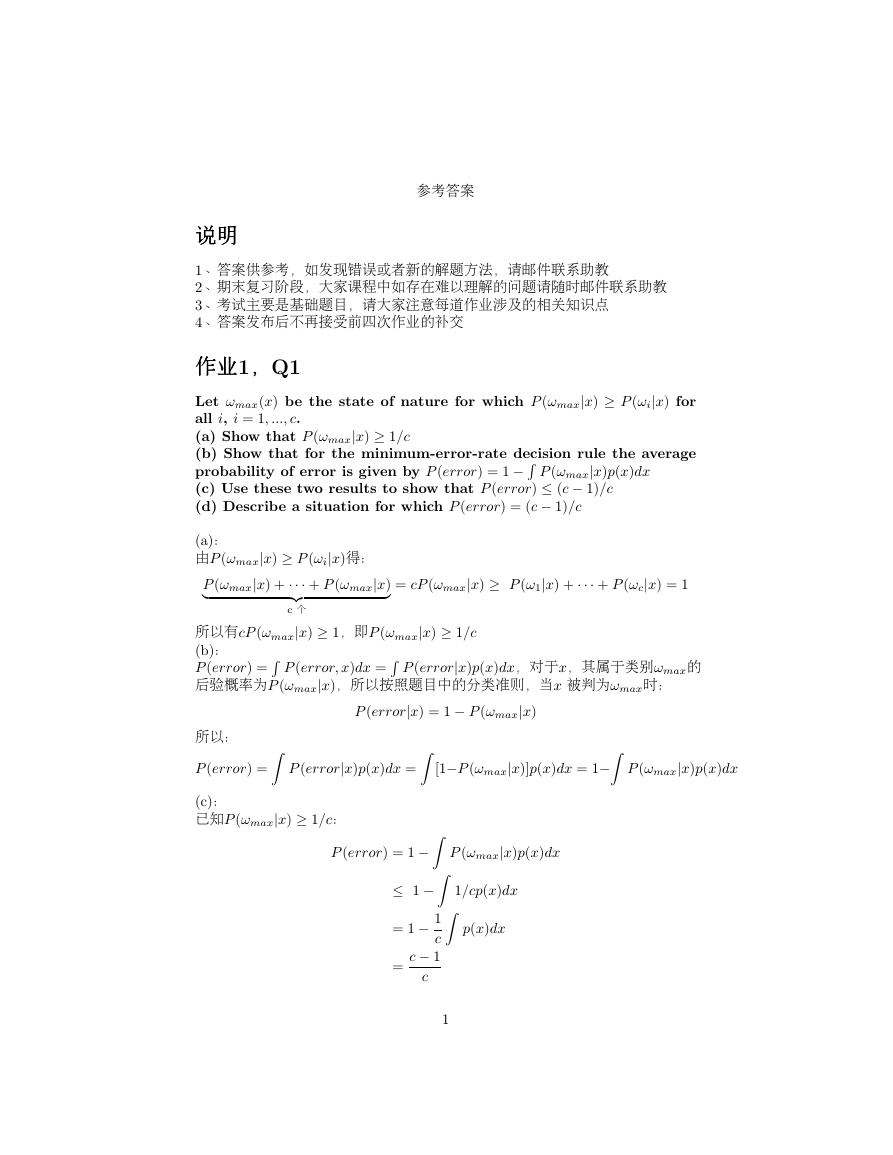

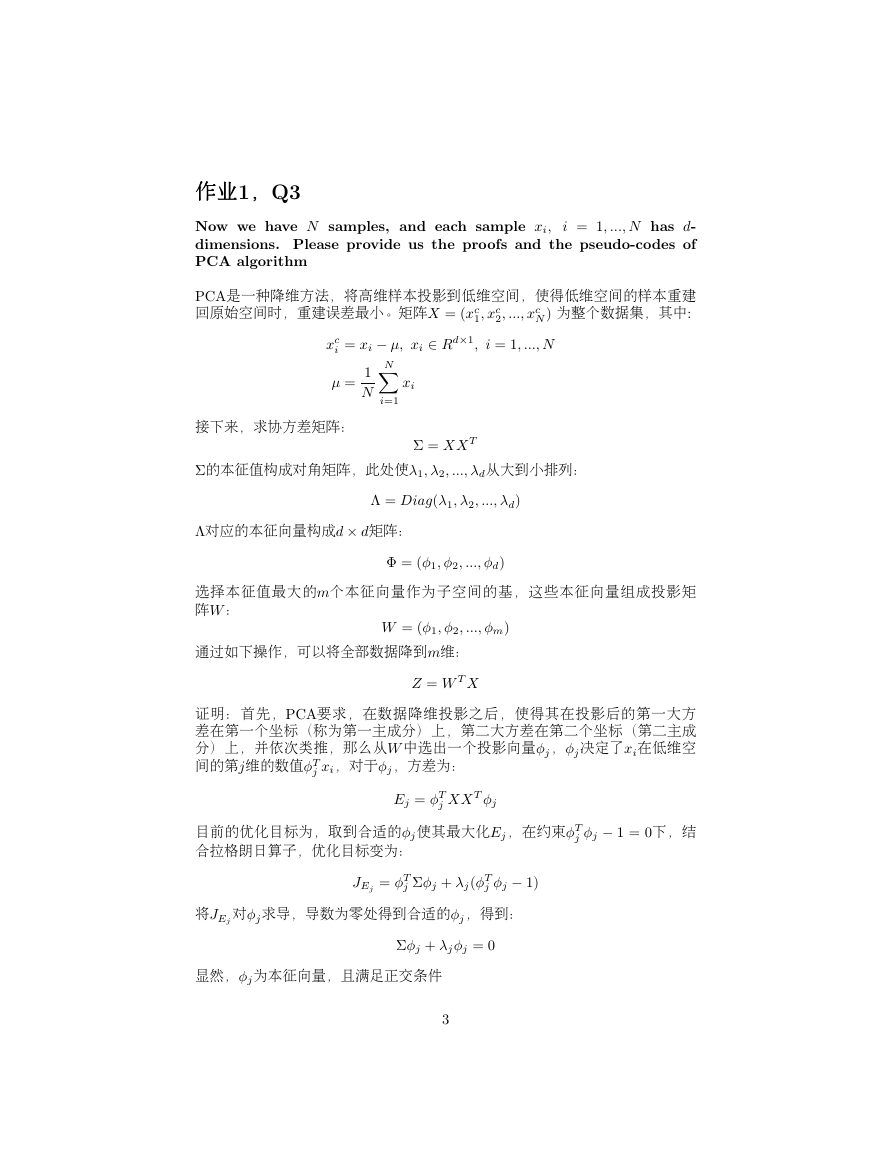

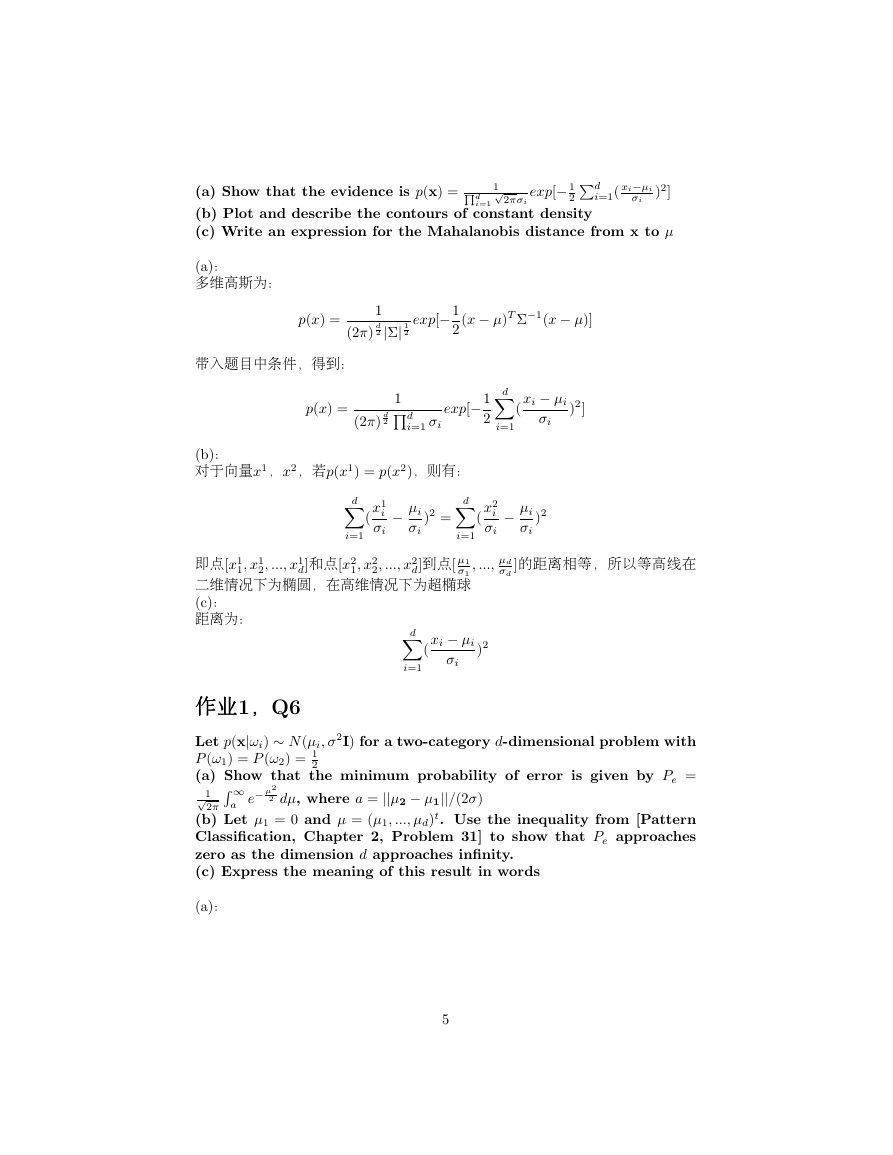
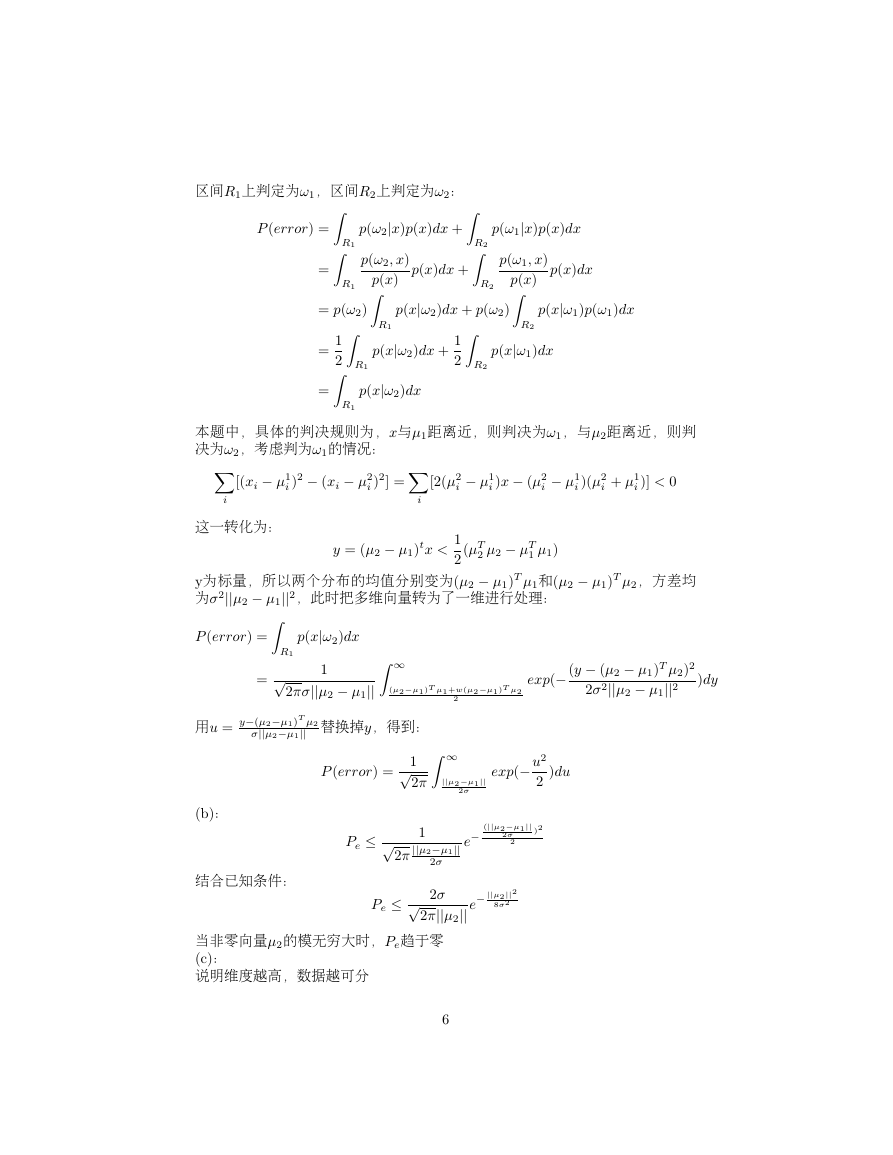
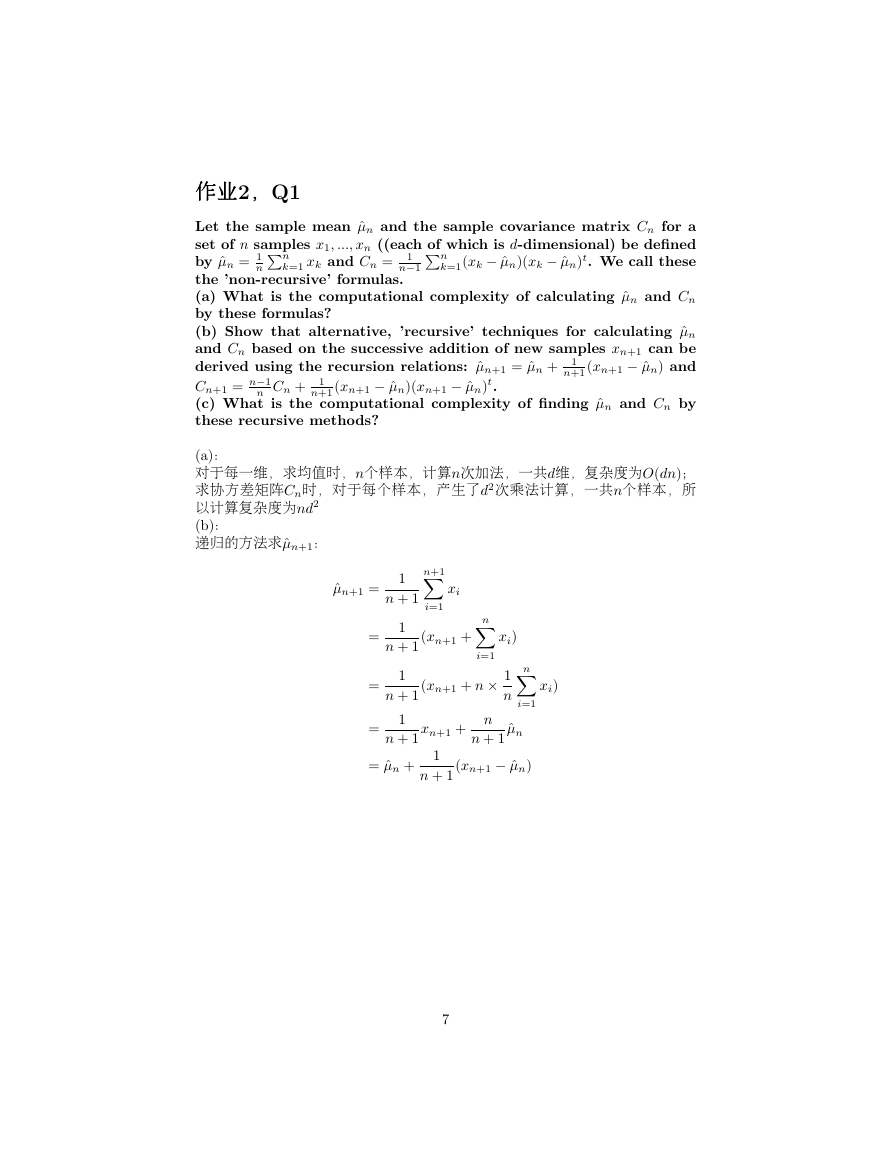
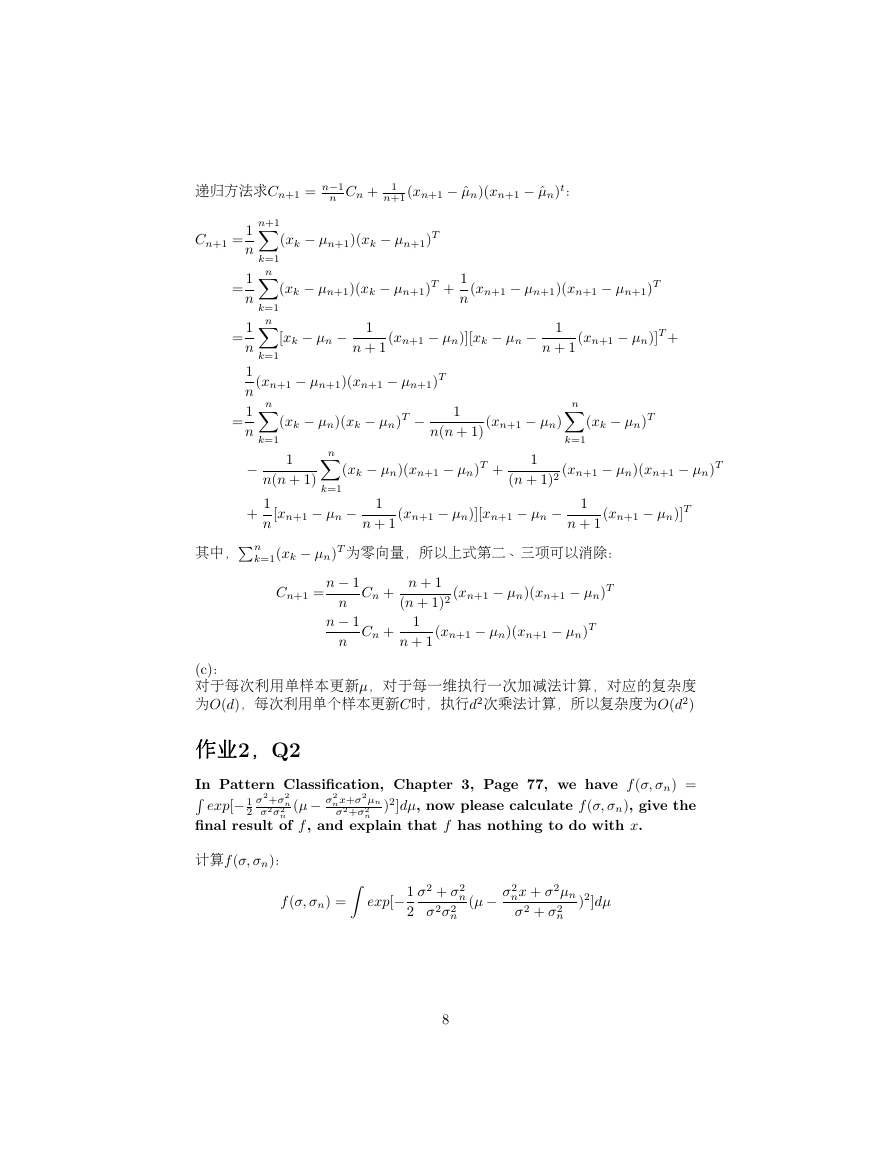








 2023年江西萍乡中考道德与法治真题及答案.doc
2023年江西萍乡中考道德与法治真题及答案.doc 2012年重庆南川中考生物真题及答案.doc
2012年重庆南川中考生物真题及答案.doc 2013年江西师范大学地理学综合及文艺理论基础考研真题.doc
2013年江西师范大学地理学综合及文艺理论基础考研真题.doc 2020年四川甘孜小升初语文真题及答案I卷.doc
2020年四川甘孜小升初语文真题及答案I卷.doc 2020年注册岩土工程师专业基础考试真题及答案.doc
2020年注册岩土工程师专业基础考试真题及答案.doc 2023-2024学年福建省厦门市九年级上学期数学月考试题及答案.doc
2023-2024学年福建省厦门市九年级上学期数学月考试题及答案.doc 2021-2022学年辽宁省沈阳市大东区九年级上学期语文期末试题及答案.doc
2021-2022学年辽宁省沈阳市大东区九年级上学期语文期末试题及答案.doc 2022-2023学年北京东城区初三第一学期物理期末试卷及答案.doc
2022-2023学年北京东城区初三第一学期物理期末试卷及答案.doc 2018上半年江西教师资格初中地理学科知识与教学能力真题及答案.doc
2018上半年江西教师资格初中地理学科知识与教学能力真题及答案.doc 2012年河北国家公务员申论考试真题及答案-省级.doc
2012年河北国家公务员申论考试真题及答案-省级.doc 2020-2021学年江苏省扬州市江都区邵樊片九年级上学期数学第一次质量检测试题及答案.doc
2020-2021学年江苏省扬州市江都区邵樊片九年级上学期数学第一次质量检测试题及答案.doc 2022下半年黑龙江教师资格证中学综合素质真题及答案.doc
2022下半年黑龙江教师资格证中学综合素质真题及答案.doc